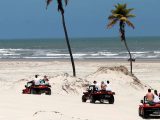Este post também está disponível em:
Português
English

Mangue Seco is a small fishing village in Jandaíra, a Brazilian municipality in the state of Bahia, it is the last beach at the northern end of the Bahian coast, bordering the state of Sergipe (the population does not exceed 200 inhabitants).
The beauty of Mangue Seco was well portrayed in the soap opera Tieta, broadcast by Rede Globo and inspired by the novel Tieta do Agreste, by Jorge Amado.
Mangue Seco is located on the banks of the Rio Real, on the border between Bahia and Sergipe, 242 km from Salvador via the Green Line. However, the most practical way to get there is via Aracaju.

With the inauguration in 2010 of the Joel Silveira Bridge, which crosses the Vaza-Barris River, you can follow the beaches via the south coast of Sergipe, following the road to Porto da Nangola where there is the Gilberto Amado bridge in the village of Porto do Mato, it is possible to cross the Rio Real to Mangue Seco.
The few streets of Mangue Seco are covered with fine, soft sand.
All along the shore, inns, bars, restaurants and fishermen’s houses are scattered, creating a good support structure for tourists.
Video about Mangue Seco in Bahia


Mangue Seco na Bahia

Mangue Seco - Guia de Turismo Completo25:28

Mangue Seco e Praia do Saco

Mangue Seco - Reportagem04:14
Although famous, the small village actually has the real name of Santa Cruz da Bela Vista.
The leisure options are varied, with programs that satisfy from surfers, who on the beaches of the region find peaks of great waves, to fishermen, who in the calm waters of the rivers can hook the most varied fish.

Among them are stingrays, dogfish and carapebas, as well as the manatee, a rare species, usually found in the Amazon River, which in the calm waters of the Rio Fundo, another of the several rivers that cut through Mangue Seco, found a favorable habitat to reproduce.
The Rio Real is also worth mentioning. Its waters, a little salty, resemble the waters of the sea and are a real surprise for the unsuspecting.
The salinity amuses bathers with the ease of simply floating and relaxing at the taste of the river.
The village lies between the mouth of the Rio Real – which day by day is digging its banks – and the immense dunes that move with the wind and advance wanting to cover everything.

The difficulty of access – exclusively by boat, across the Rio Real – is what makes Mangue Seco more attractive and keeps it naturally rustic.
At night, children still play rounders and hide-and-seek, while visitors listen to old stories told by fishermen or participate in serenades with the native population.
Dimly lit, the village offers a starry night, with extraordinary beauty during periods of full moon.
See the map Costa dos Coqueiros

The landscape, which is always stunning, gains an extra attraction when the reflection of the moon intensifies in the waters of the rivers that surround the region.
In a privileged position, in the bay of Estância, Mangue Seco witnesses the meeting of the rivers Real, Piauí, Fundo, Guararema, Priapu and Saguí with the Atlantic Ocean.
The mixture of fresh and salt water provides the formation of extensive areas of mangrove and, consequently, the abundance of seafood. On the river beach, the coconut trees lean over the water, bending their trunks.
All along the shore, inns, bars, restaurants and fishermen’s houses are scattered, creating a good support structure for tourists.
Tourism and Travel Guide to Mangue Seco in Bahia



















